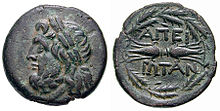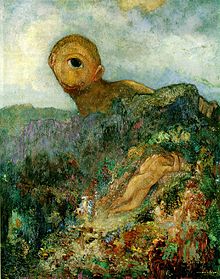Cyclops

Cyclops ( ancient Greek Κύκλωπες Kýklopes " circle- eyed", Sg. Κύκλωψ Kýklops "Kyklops") or Cyclops (Germanized from Latin Cyclopes , Sg. Cyclops ) are characters in Greek mythology who differ from one another in terms of ancestry, external appearance and location. What they have in common is the unusual appearance of the eyes as circular eyes or as a single eye on the forehead. Three types of Cyclopes were already distinguished in antiquity: the Hesiodian thunderstorm demons, which were later reinterpreted as volcanic demons, the Homeric giants and finally the mythical builders.
The term cyclopia for certain skull malformations is derived from the figure .
Mythical forms
Demons
In Hesiod's theogony , the Cyclops are the godlike but one-eyed sons of Uranus and Gaia , their siblings are the Hekatoncheirs and the Titans . They got the names Brontes (Βρόντης), Steropes and Arges. Like their siblings, they are locked in by Uranos in Gaia, the earth, and only freed by Zeus , who receives lightning, fuse and thunder from them for his fight against the titans . In Hesiod's Eoien they are killed by Apollo .
In the library of Apollodorus they are banished to Tartaros with their siblings . They are brought up again by the titans after the emasculation of Uranus, but they are sent back by Kronos . Zeus frees her after ten years of fighting the titans by killing her guardian Kampe , and receives the weapons as with Hesiod as well as a helmet for Hades and a trident for Poseidon . They are killed by Apollo when he took revenge on Zeus for the death of his son Asclepius . Asklepios had resurrected several dead and was killed by Zeus with the lightning he received from the Cyclops. According to later tradition, the arrow with which the Cyclops were killed is said to have been placed under the stars.
In Nonnos Dionysiaka , the Cyclops accompany Dionysus on his campaign against India. Their names are Brontes, Steropes, Arges, Euryalos, Elatreus , Trakhios and Halimedes. Polyphemus is the only Cyclops who does not go on the journey .

In later legend they appear as Hephaestus ' assistants who forge weapons inside volcanoes. The reinterpretation of thunderstorm demons to volcanic demons results from the fact that volcanic phenomena were on the one hand related to thunderstorms and on the other hand were interpreted as divine blacksmithing activities. The first approaches to this idea can be found in Euripides , who indicates Etna as Polyphem's residence . As Hephaestus' helpers, they appear for the first time with Callimachus , who lets them live on the volcanic Aeolian Islands . In Virgil's Aeneid , the Cyclops forge Brontes, Steropes and Pyracmon on the island Volcania lightning and thunderbolts for Jupiter , a chariot of Mars and a shield for Athena , in the Georgica can Virgil in Etna live.
At Callimachos Artemis receives the bow from the Cyclops, which she uses for hunting.
Homeric Cyclops
The better-known Cyclops, whom Odysseus met on his wanderings according to Homer's Odyssey , were the sons of Poseidon. Odysseus and his men had great difficulties with Polyphem in particular: he locked Odysseus and twelve of his companions in his cave and ate six of the men before Odysseus and his remaining companions managed to escape by tricking and blinding Polyphemus. Homer does not describe the Cyclops as one-eyed, possibly because he assumes that one-eyed is known.

builder
Another development of the legend can be found in the mention of the Cyclops, who came to Strabo from Lycia and built walls and other structures in Tiryns and Mycenae , which are called " Cyclops walls ". This is an aetiological legend , with the help of which the ruins from the Late Helladic, and in particular their masonry, which were not understood for Greek antiquity , should be explained. The Hellenes of antiquity did not trust their ancestors to handle the huge stone blocks and their almost seamless assembly, so that these buildings were attributed to mythical figures. For this, loans were taken from the other Cyclops.
Origin of the Cyclopean belief
Historians and mythologists speculate that the legends of the one-eyed giants are based on gorillas, embryonic errors ( cyclopia ), or on elephant skulls . They believe that the skull's large nasal opening has been mistakenly interpreted as a single large eye socket. Some ancient figurative representations of the Cyclopean head also show similarities to the skull structure of elephants. In addition to various large species of elephants that lived on some Mediterranean islands in prehistoric times, there were also some pygmy elephants of various sizes, for example on Malta, Crete, Cyprus and Sicily. Many of these species, along with other endemic island forms such as dwarf deer and dwarf hippopotamus, were in some cases only exterminated relatively late by humans. Even the skulls of very small species of pygmy elephant were significantly larger than those of humans, which then resulted in representations of Cyclopes that were clearly larger than human. Finds of such elephants often come from caves into which the animals fell, which meant that their remains could be well preserved. Polyphemus also lived in a cave, where elephant fossils possibly found in caves formed the origins of this myth. Most of the old Cyclopean representations show these figures 3–5 m tall, which is why it is more likely that skulls from dwarf elephants and not large species such as deinotheria formed the origins of these mythical figures .
The Austrian paleontologist Othenio Abel first speculated in 1914 about the possibility that the Cyclops myth is based on fossil elephant skulls . To support his theory, Abel claimed that the Greek philosopher Empedocles had already made a similar assumption. Willy Ley added to Abels' thesis in 1948 that Giovanni Boccaccio also referred to Empedocles when he used fossilized mammoth bones to explain the legend of the Cyclops. Although neither the traditional writings of Empedocles nor the works of Boccaccio contain descriptions of bone finds and references to Cyclops, Abels and Ley's theories were later adopted unchecked, and elephant skulls were used as an explanation for the ancient belief in one-eyed giants. The etymology of the word Cyclops, which can be translated as “ring-eyed”, speaks against this theory . Thus, the ring symbolism (infinity - eternity, symbol of the sun, fire, knowledge) and the proximity to the blacksmith trade, which has been mystified, seem to have coined the term, especially since Cyclops were active as blacksmiths. The embryonic malformation Cyclopia occurs too seldom for it to have influenced the Cyclopean myth.
The original descriptions of the Cyclops and the name itself initially only speak of round or ring-eyed. According to the wording of the sources, the idea of one-eyed Cyclops with a central eye in the forehead is not compelling. In Homer's Odyssey, the cunning Odysseus blinds the Cyclops Polyphemus with a beam heated in the fire, which has led to the assumption of one-eyedness. It is explicitly carried out by Hesiod in the theogony .
presentation
Ancient artists depicted the Cyclops as giants with a single large eye on their foreheads, but often in such a way that the eyes were at least hinted at in the usual place underneath (relief of the Capitoline Museum, Cyclops in the forge of Hephestus). Modern depictions mostly see Cyclopes with one eye and are mainly influenced by Homer's Polyphemus.
literature
- Wilhelm Heinrich Roscher : Cyclops . In: Extensive encyclopedia of Greek and Roman mythology . Volume 2, Dept. 1: Iache - Kyzikos. Teubner, Leipzig 1894, Sp. 1676–1690.
- C. Calame: La legend du Cyclope dans le folklore européen et extra-European. Un jeu de transformations narratives. In: Études de lettres. 10, 1977, pp. 45-79.
- P. Julien: Le thème du Cyclope dans les littératures greque et latine . Paris 1941.
- Robert Mondi: The Homeric Cyclopes. Folktale, Tradition, and Theme. In: Transactions of the American Philological Association. 113, 1983, pp. 17-38.
- Karl Kerényi : The Mythology of the Greeks - The Gods and Human Stories . dtv, Munich 1994, ISBN 3-423-30030-2 .
- Michael Grant , John Hazel: Lexicon of ancient myths and figures . dtv, Munich 2004, ISBN 3-423-32508-9 .
- Robert von Ranke-Graves : Greek Mythology - Sources and Interpretation . rororo, Hamburg 2001, ISBN 3-499-55404-6 .
- Hesiod : Theogony or Gender of the Gods and Goddesses . ( Text in the Gutenberg-DE project ).
Web links
- The hesiodschen Kyklopes in Theoi Project (English)
- The Homeric Kyklopes in Theoi Project (English)
Individual evidence
- ↑ Hellanikos Fragment 176 in the Scholion zu Hesiod , Theogonie 139 ( FGrHist 4 F 88).
- ↑ Hesiod : Theogony 139 ff.
- ↑ Hesiod: Theogony 492 ff.
- ^ Hesiod: Eoien , fragment 64.
- ^ Pseudo-Apollodor: Libraries of Apollodor 1, 1-7.
- ^ Pseudo-Apollodor: Bibliotheke 3, 118-122.
- ↑ Eratosthenes : Katasterismos 29.
- ↑ Nonnos : Dionysiaka 14, 52 ff; 28, 172 ff.
- ↑ Roscher: Detailed lexicon of Greek and Roman mythology. Volume 2, Dept. 1. Col. 1678.
- ↑ Euripides : The Cyclops 297.
- ↑ Callimachus : Hymn to Delos 46 f.
- ↑ Virgil : Aeneis 8, 418 ff.
- ^ Virgil: Georgica 1, 471.
- ↑ Callimachus: Hymn to Artemis 46 ff.
- ↑ Homer , Odyssey 9, 105-565.
- ↑ Luca Giuliani : Image and Myth. History of picture narration in Greek art. CH Beck, Munich 2003, ISBN 3-406-50999-1 , p. 107.
- ^ Wilhelm Heinrich Roscher : Cyclops 2. In: Wilhelm Heinrich Roscher (Hrsg.): Extensive lexicon of Greek and Roman mythology . Volume 2.1, Leipzig 1894, Col. 1683; see. also: Luca Giuliani: Image and Myth. History of picture narration in Greek art. CH Beck, Munich 2003, p. 107, who assumes that in the description of the Cyclopes in the Odyssey, “older fairy tale traditions are used”, through which the anatomical features were already known to the reader.
- ^ Strabo : Geographica, book 8, 6, 11
- ↑ Theodor Zell: Polyphemus a gorilla. A scientific and constitutional investigation of Homer's Odyssey, Book IX V. 105 ffge. W. Junk, Berlin, pasted over by Theodor Oswald Weigel, Leipzig, 1901
- ↑ So already Friedrich Schatz : The Greek gods and human freaks. Bergmann, Wiesbaden 1901, p. 9ff .; s. also Manfred Reitz : puzzles. Crypto-Zoology - Myths, Traces, and Evidence. S. Hirzel Verlag, Stuttgart 2005, p. 32; Ursus-Nikolaus Riede, Martin Werner: General and special pathology. Springer-Verlag, 2nd revised edition 2017 (1st edition 2009), p. 216, Fig.15.8
- ^ Catalog of the scientific collections of the Humboldt University of Berlin: Presentation of an elephant skull as a cyclops (accessed on January 29, 2010)
- ^ Adrienne Mayor: The First Fossil Hunters: Dinosaurs, mammoths, and myth in Greek and Roman times . 7th edition. Princeton University Press, New Jersey 2011, ISBN 978-0-691-15013-0 , pp. 6-7 .
- ↑ B. Engmann: The stuff that myths are made of. How fossils became mythical creatures . Hirzel-Verlag, Stuttgart 2012, ISBN 978-3-7776-2262-0 .
- ↑ Christine Walde: Cyclops. In: The New Pauly. Encyclopedia of Antiquity. Volume 6, p. 962.

